The Barley Flake Market is estimated to be valued at USD 8.8 billion in 2025 and is projected to reach USD 15.6 billion by 2035, registering a compound annual growth rate (CAGR) of 5.9% over the forecast period.
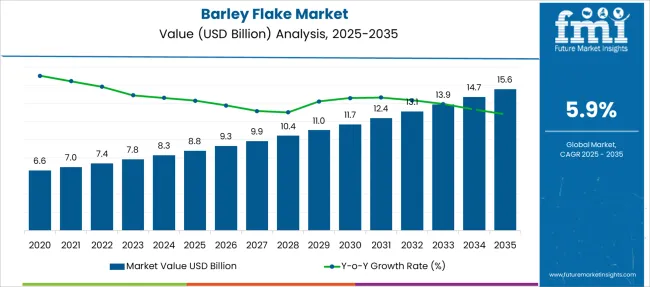
| Metric | Value |
|---|---|
| Barley Flake Market Estimated Value in (2025 E) | USD 8.8 billion |
| Barley Flake Market Forecast Value in (2035 F) | USD 15.6 billion |
| Forecast CAGR (2025 to 2035) | 5.9% |
The barley flake market is expanding steadily due to increasing consumer interest in healthy and natural food products. Growing awareness about the nutritional benefits of barley flakes, including high fiber and essential vitamins, has supported demand across diverse consumer groups.
The trend toward organic and clean-label foods has led to greater preference for organically grown barley, driving segment growth. Additionally, the food and beverage industry has incorporated barley flakes into a variety of products such as breakfast cereals, snacks, and health bars to meet rising demand for wholesome ingredients.
Innovations in processing technologies have enhanced product quality and shelf life, encouraging broader adoption. The expansion of health-conscious consumer bases in emerging and developed markets continues to fuel market growth. Segmental demand is expected to be led by the Organic nature segment, Hulled Barley Flake as the preferred product type, and Food and Beverage as the primary end-use industry.
The market is segmented by Nature, Product Type, End Use, and Distribution Channel and region. By Nature, the market is divided into Organic and Conventional. In terms of Product Type, the market is classified into Hulled Barley Flake, Hulless Barley Flake, Pearl Barley Flake, and Malted Barley Flake. Based on End Use, the market is segmented into Food and Beverage, Functional Food, and Animal Feed. By Distribution Channel, the market is divided into Direct/B2B Sales Channel and Indirect/B2C Sales Channel. Regionally, the market is classified into North America, Latin America, Western Europe, Eastern Europe, Balkan & Baltic Countries, Russia & Belarus, Central Asia, East Asia, South Asia & Pacific, and the Middle East & Africa.
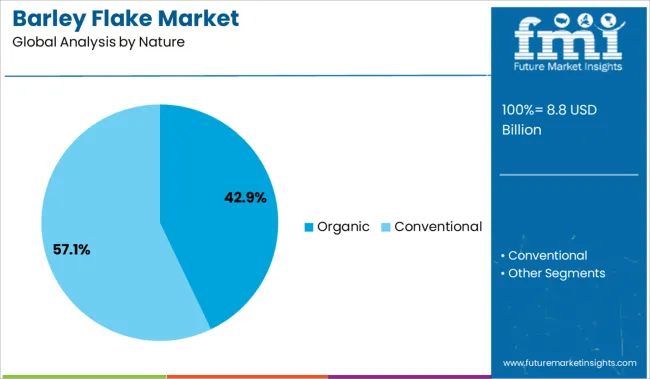
The Organic barley flake segment is projected to account for 42.9% of the market revenue in 2025, securing its position as the leading nature segment. The rise in organic product consumption, driven by increasing health awareness and concerns about pesticide residues, has fueled this growth.
Consumers have sought barley flakes grown without synthetic chemicals or genetically modified organisms, aligning with their preference for natural and sustainable food sources. Retailers and food manufacturers have expanded their organic product lines in response to consumer demand.
Additionally, the organic segment benefits from premium pricing, which supports profitability for producers and suppliers. With ongoing emphasis on clean eating and sustainable agriculture, the Organic segment is expected to maintain a dominant market share.
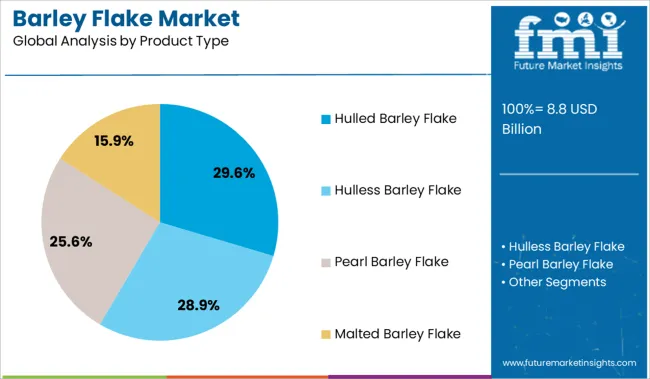
The Hulled Barley Flake segment is anticipated to contribute 29.6% of the barley flake market revenue in 2025, establishing it as a key product category. Hulled barley flakes are valued for retaining their bran and germ layers, which provide superior nutritional content compared to pearled variants.
This product type is preferred by health-conscious consumers and manufacturers aiming to develop high-fiber and nutrient-dense food products. Advances in processing methods have improved the texture and palatability of hulled barley flakes, making them suitable for a wide range of applications.
The segment has been supported by growing incorporation into breakfast foods, bakery items, and snack products. As consumer focus on nutrient-rich diets increases, the Hulled Barley Flake segment is expected to sustain growth.
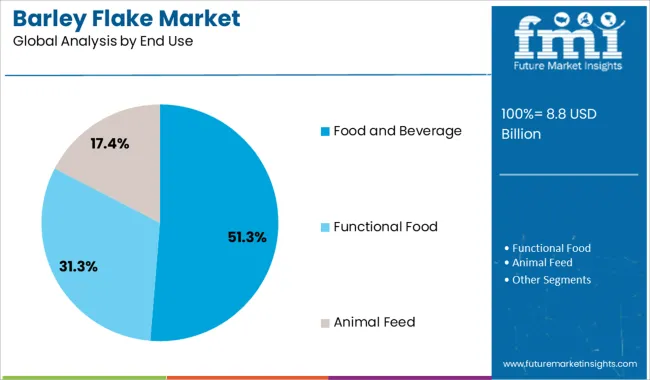
The Food and Beverage segment is projected to hold 51.3% of the barley flake market revenue in 2025, leading all end-use industries. This segment has expanded due to the incorporation of barley flakes in diverse product categories such as cereals, snacks, beverages, and health supplements.
Food manufacturers have recognized barley flakes as a functional ingredient that enhances texture and nutritional value. Consumer demand for healthy and convenient food options has driven product innovation in this sector.
Additionally, the rise of plant-based and whole-grain food trends has bolstered the use of barley flakes. Retail penetration and product availability in supermarkets and specialty stores have further accelerated growth in the food and beverage segment. As consumer preferences continue to favor nutritious and natural foods, this segment is expected to remain the dominant end-use channel.
Increased health trends and consumer awareness are two important factors that could boost the market for barley flakes. Because of their hectic lifestyles, consumers are looking for food products with high nutritional value and ease of preparation, and barley flakes may be a good option because they are high in nutrients and require little cooking time. As a result, as barley flakes become more in line with consumer preferences, the barley flake market may expand.
The growing popularity of clean-label products could be a major driver of growth in the barley flakes market. Barley flakes can be incorporated into a variety of food products such as cookies, bread, biscuits, breakfast cereals, and so on, and can thus be used as a food ingredient by food product manufacturers to develop innovative and healthy food products, potentially attracting health-conscious consumers who prefer to use clean-label food products.
The presence of similar products such as oat flakes, as well as a lack of awareness about barley flakes, can be a significant restraint for the barley flakes market. Oat flakes are very popular among consumers due to their high nutritional value, variety of flavors, and ability to be used in the preparation of beverages, muffins, bars, cookies, and so on, and thus can serve as a significant restraint for the barley flakes market.
The Asia-Pacific region currently dominates the barley flakes market and will continue to do so during the forecast period, thanks to major manufacturers launching innovative products in order to diversify their portfolio with barley-based multigrain cereals and breakfast products.
According to Future Market Insights, North America is expected to grow rapidly due to its nutritional content, which is in high demand among the region's health-conscious citizens.
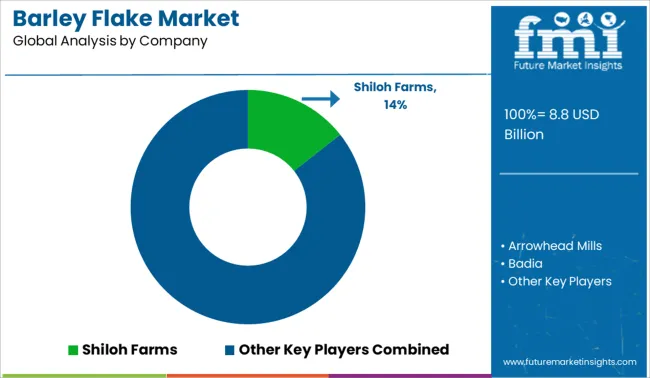
Some of the key participants present in the global Barley Flake market include King Arthur Flour, Shiloh Farms, Bob's Red Mill, Honeyville, Inc., Naturally Yours, Vee Green Organic Life Care Private Limited, Helsinki Mylly Oy, Briess Malt & Ingredients Co., Rude Health, etc., among others.
| Report Attribute | Details |
|---|---|
| Growth Rate | CAGR of 5.87% from 2025 to 2035 |
| Base Year for Estimation | 2024 |
| Historical Data | 2020 to 2024 |
| Forecast Period | 2025 to 2035 |
| Quantitative Units | Revenue in USD Million, Volume in Kilotons, and CAGR from 2025 to 2035 |
| Report Coverage | Revenue Forecast, Volume Forecast, Company Ranking, Competitive Landscape, Growth Factors, Trends, and Pricing Analysis |
| Segments Covered | Nature, Product Type, End Use, Distribution Channel, Region |
| Regions Covered | North America; Latin America; Europe; Asia Pacific; Middle East & Africa |
| Key Countries Profiled | USA, Canada, Brazil, Argentina, Germany, United Kingdom, France, Spain, Italy, Nordics, BENELUX, Australia & New Zealand, China, India, ASIAN, GCC Countries, South Africa |
| Key Companies Profiled | King Arthur Flour; Shiloh Farms; Bob's Red Mill; Honeyville, Inc.; Naturally Yours; Vee Green Organic Life Care Private Limited; Helsinki Mylly Oy; Briess Malt & Ingredients Co.; Rude Health |
| Customization | Available Upon Request |
The global barley flake market is estimated to be valued at USD 8.8 billion in 2025.
The market size for the barley flake market is projected to reach USD 15.6 billion by 2035.
The barley flake market is expected to grow at a 5.9% CAGR between 2025 and 2035.
The key product types in barley flake market are organic and conventional.
In terms of product type, hulled barley flake segment to command 29.6% share in the barley flake market in 2025.






Full Research Suite comprises of:
Market outlook & trends analysis
Interviews & case studies
Strategic recommendations
Vendor profiles & capabilities analysis
5-year forecasts
8 regions and 60+ country-level data splits
Market segment data splits
12 months of continuous data updates
DELIVERED AS:
PDF EXCEL ONLINE
Barley Market Size, Growth, and Forecast for 2025 to 2035
Barley Protein Market – Growth, Demand & Plant-Based Protein Trends
Feed Barley Market Analysis - Size, Share, and Forecast Outlook 2025 to 2035
Malted barley flour Market Size and Share Forecast Outlook 2025 to 2035
Flakes Making Machine Market Size and Share Forecast Outlook 2025 to 2035
Flake Ice Machines Market - Industry Growth & Market Demand 2025 to 2035
Flake Graphite Market
Flaked Shortening Market
Deflaker Market Growth – Trends & Forecast 2024-2034
Pea Flakes Market Size and Share Forecast Outlook 2025 to 2035
Market Share Breakdown of Pea Flakes Manufacturers
Yeast Flakes Market
Potato Flakes Market Analysis - Size, Share, and Forecast Outlook 2025 to 2035
Banana Flakes Market Size and Share Forecast Outlook 2025 to 2035
Market Leaders & Share in the Potato Flakes Industry
Competitive Landscape of Edible Flakes Providers
Cereal Flake Market
UK Potato Flakes Market Report – Growth, Demand & Forecast 2025-2035
USA Potato Flakes Market Growth – Innovations, Trends & Forecast 2025-2035
ASEAN Potato Flakes Market Report – Growth, Demand & Forecast 2025-2035

Thank you!
You will receive an email from our Business Development Manager. Please be sure to check your SPAM/JUNK folder too.
Chat With
MaRIA